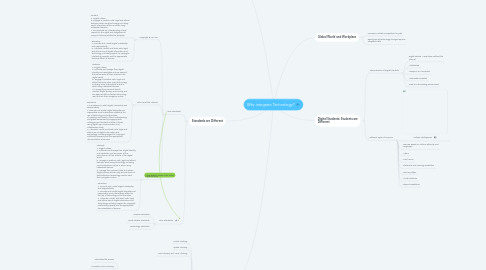
1. Teachers are Different: 21st Century Prepared
1.1. Professors model technology integration in PTE
1.2. Model Technology integration for your students
1.3. Universal Design for Learning
1.3.1. 3 Principles
1.3.1.1. Multiple Means of Representation (What)
1.3.1.2. Multiple Means of Engagement (Why)
1.3.1.3. Multiple Means of Action and Expression (How)
1.3.2. Why is technology important to UDL?
1.3.2.1. Assisstive Technology
1.3.2.2. Accessibility
1.3.2.3. Online Resourses
1.3.2.3.1. TechMatirx
1.3.2.3.2. Common Sense Media
2. Standards are Different
2.1. ISTE Standards
2.1.1. Copyright & Fair Use
2.1.1.1. Student 2. Digital Citizen b. Engage in positive, safe, legal and ethical behavior when using technology, including social interactions online or when using networked devices. c. Demonstrate an understanding of and respect for the rights and obligations of using and sharing intellectual property.
2.1.1.2. Educators 4. Promote and Model Digital Citizenship and Responsibility a. Advocate, model, and teach safe, legal and ethical use of digital information and technology, including respect for copyright, intellectual property and the appropriate documentation of sources.
2.1.2. Safe Use of the Internet
2.1.2.1. Students 2. Digital Citizen a. Cultivate and manage their digital identity and reputation and are aware of the permanence of their actions in the digital world. b. Engage in positive, safe, legal and ethical behavior when using technology, including social interactions online or when using networked devices. d. Manage their personal data to maintain digital privacy and security and are aware of data-collection technology used to track their navigation online.
2.1.2.2. Educators 4. Promote and Model Digital Citizenship and Responsibility c. Promote and model digital etiquette and responsible social interactions related to the use of technology and information. d. Develop and model cultural understanding and global awareness by engaging with colleagues and students of other cultures using digital age communication and collaboration tools. a. Advocate, model, and teach safe, legal and ethical use of digital information and technology, including respect for copyright, intellectual property and the appropriate documentation of sources.
2.1.3. Cyberbullying
2.1.3.1. Students 2. Digital Citizen a. Cultivate and manage their digital identity and reputation and are aware of the permanence of their actions in the digital world. b. Engage in positive, safe, legal and ethical behavior when using technology, including social interactions online or when using networked devices. d. Manage their personal data to maintain digital privacy and security and are aware of data-collection technology used to track their navigation online.
2.1.3.2. Educators 4. Promote and Model Digital Citizenship and Responsibility c. Promote and model digital etiquette and responsible social interactions related to the use of technology and information. a. Advocate, model, and teach safe, legal and ethical use of digital information and technology, including respect for copyright, intellectual property and the appropriate documentation of sources.
2.2. Ohio Standards
2.2.1. Science Standards
2.2.2. Social Studies Standards
2.2.3. Technology Standards
3. 21st Century Skills
3.1. Critical Thinking
3.2. Spatial Thinking
3.3. Visual Literacy and Visual Thinking
3.4. Nonlinear Thinking
3.4.1. Benefits of Multimedia
3.4.1.1. Students
3.4.1.1.1. Stimulates the Senses
3.4.1.1.2. Promotes Active Learning
3.4.1.1.3. Provides Practice of Using 21st Century Skills
3.4.1.1.4. Opportunities for Ethical Use of Technologies
3.4.1.1.5. Enhances Nonlinear Thinking
3.4.1.2. Teachers
3.4.1.2.1. Helps Communicate Instructions
3.4.1.2.2. Promotes Practice in Facilitating Learning
3.4.1.2.3. Offers Opportunities to Differentiate Instruction
3.5. Digital Age Reflection
3.6. Creativity and Innovation
3.7. Communication & Collaboration
3.8. Research & Information Literacy
4. Global World and Workplace
4.1. Increase in Global Competition for jobs
4.2. Rapid pace of technology changes requires adaptable skills
5. Digital Students: Students are Different
5.1. Characteristics of Digital Students
5.1.1. Digital natives - never been without the Internet
5.1.2. Multitaskers
5.1.3. Always on or connected
5.1.4. Multimedia Oriented
5.1.5. Used to a stimulating Environment
5.2. Different Types of Learners
5.2.1. Multiple Intelligences
5.2.2. Learners Based on Culture, Ethnicity, and Languages
5.2.3. Autism
5.2.4. ADD/ADHD
5.2.5. Intellectual and Learning Disabilities
5.2.6. Learning Styles
5.2.7. At Risk Students
5.2.8. Physical Disabilities

